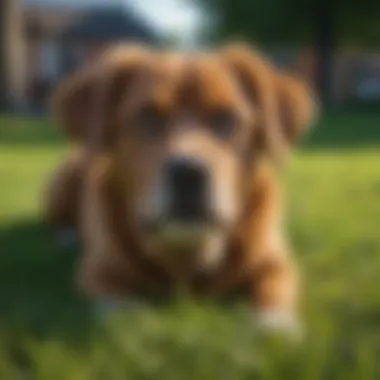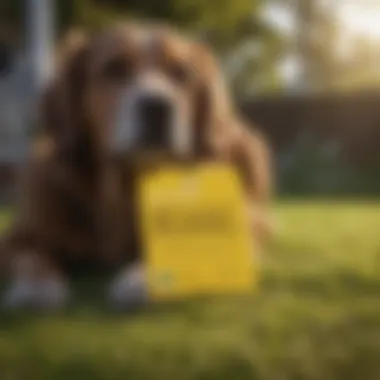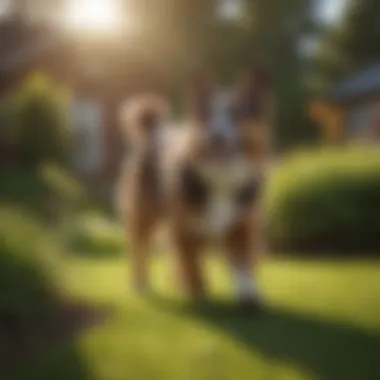Understanding Dog Urine's Effects on Lawn Health


Overview of the Topic
Definition and Importance
The relationship between dog urine and lawn health is significant but often overlooked. Dog urine is high in nitrogen, a nutrient beneficial for plant growth in small amounts. However, in concentrated doses, it can lead to damage and even kill patches of grass. This article explores how this phenomenon occurs, emphasizing the importance of understanding the effects of dog urine on lawns. Knowledge in this area is essential for pet owners who wish to maintain a healthy yard while enjoying companionship with their dogs.
Current Trends
As pet ownership rises, discussions surrounding dog urine and lawn health are becoming more common. Homeowners are increasingly seeking solutions that allow for a balance between nurturing their pets and maintaining their landscapes. This trend reflects a growing awareness of sustainable practices in lawn care that accommodate both pet and environmental health. The market is seeing innovations in products designed to mitigate the effects of dog urine, as well as education on selecting grass varieties that are less prone to damage.
Key Techniques and Practices
Step-by-Step Guide
- Assess the Damage: Regularly inspect your lawn for signs of damage caused by dog urine, such as yellow or brown patches.
- Identify Grass Type: Understand the type of grass in your yard. Some varieties, like perennial ryegrass, are less susceptible to urine damage.
- Watering Strategies: Establish a watering routine that dilutes the nitrogen concentration from dog urine. This may involve watering your lawn more frequently after your dog urinates.
- Use of Amendments: Consider applying lawn amendments such as gypsum that can help reduce the nitrogen level in the soil.
- Training Your Dog: Train your dog to use specific areas for urination. This approach limits damage to designated spots rather than spreading it across the lawn.
Tools and Equipment Needed
- Watering Can or Hose: To dilute urine spots effectively after your dog has urinated.
- Soil Test Kit: To check nutrient levels in your soil, which can guide your care practices.
- Lawn Amendments: Gypsum or other nitrogen-rebalancing products found at garden centers.
Challenges and Solutions
Common Obstacles
Many homeowners face challenges when trying to maintain a healthy lawn with a dog. These include:
- Inconsistent Watering: Forgetting to water can lead to concentrated nitrogen buildup.
- Limited Knowledge: Some may not know about dog urine's effects and the best management practices.
- Grass Type Limitations: Certain grass types are inherently more vulnerable to damage, complicating recovery efforts.
Innovative Solutions
Innovative approaches can mitigate lawn damage better than traditional methods:
- Selecting Resistant Grass Varieties: Choosing grass types that can endure dog urine, such as Bermuda grass or fescue, can lessen damage.
- Landscape Design: Creating a pet-friendly landscape design that incorporates areas for pets to relieve themselves without impacting the entire lawn.
- Lawn Care Products: Utilizing products that neutralize nitrogen levels and promote recovery of affected areas.
Understanding the implications of dog urine on your lawn is crucial in sustaining its vitality while being a responsible pet owner. Careful management and innovative strategies can lead to a thriving yard.
Foreword to Lawn Health
Lawn health is not merely a matter of aesthetics; it serves as a foundation for ecological balance and community engagement. A well-maintained lawn contributes positively to air quality, reduces soil erosion, and supports wildlife. It provides a space for outdoor activities and relaxation, which is important for mental well-being.
Healthy lawns are integral to residential landscapes. They act as a natural cooling system, moderating temperatures in urban areas. Moreover, they absorb carbon dioxide, helping mitigate climate change impacts. Homeowners often underestimate the role of healthy grass in promoting biodiversity or maintaining soil structure.
Understanding the challenges of maintaining a lawn is essential, especially for pet owners. Dog urine, a common issue in many households, can significantly affect grass health. Learning about lawn care practices that accommodate pets is essential for sustaining both pet ownership and environmental integrity.
Significance of Healthy Lawns
The role of a healthy lawn stretches beyond beauty. Its significance includes:
- Air Quality: Grass produces oxygen, improving the air we breathe.
- Biodiversity: Lawns can become habitats for various small wildlife.
- Erosion Control: Healthy lawns hold the soil together, reducing erosion.
- Social Interaction: Well-kept gardens encourage community members to gather.
In essence, a healthy lawn is a marker of responsible stewardship of the environment.
Common Challenges in Lawn Maintenance
Maintaining a vibrant lawn involves navigating several challenges. Factors that contribute to these challenges include:
- Weather Conditions: Excessive heat or unexpected frost can harm grass.
- Pest Control: Insects can damage the health of the lawn.
- Soil Quality: Poor nutrient levels in the soil affect grass growth.
- Pet-related Issues: Dog urine is a major concern for pet owners.
Proactively addressing these issues requires knowledge of lawn care methods that promote resilience against various stressors. Effectively understanding these dynamics, particularly concerning dog urine, will provide a pathway toward healthier lawns.
Understanding Dog Urine Composition
Understanding the composition of dog urine is vital to comprehending its impact on lawn health. Dog urine contains various chemical components, primarily nitrogen, which can significantly influence the structure and appearance of grass. By examining these constituents, we can better appreciate the interactions between pet waste and plant life. This awareness enables pet owners and lawn maintainers to manage this relationship, preserving the health of the lawn while accommodating their furry companions.
Nitrogen Levels in Dog Urine
Nitrogen is one of the primary elements found in dog urine. It is a critical nutrient for plants, playing a major role in their growth. However, the concentration of nitrogen in dog urine is substantially higher than that found in regular fertilizer.


Due to this elevated nitrogen content, areas where pets frequently urinate often show symptoms of over-fertilization, such as yellowing grass or brown spots.
- Typical nitrogen levels in dog urine can range from 0.2% to 2.0%, depending on factors such as diet and hydration.
- High nitrogen concentrations lead to aggressive growth in grass, but this can stress the plants, ultimately causing damage.
- It creates a high-nitrogen spot that can result in grass that is lush in some areas while brown in others.
Understanding these nitrogen levels helps owners create strategies to balance the lawn's nutrient needs while mitigating damage.
Other Chemical Components
Apart from nitrogen, dog urine contains other chemicals that can influence lawn health. These include urea, creatinine, and various salts. Each of these components contributes differently to the overall health of grass.
- Urea: This is another nitrogen source but in a different form. It breaks down into ammonia, which can also harm grass if present in excessive amounts.
- Creatinine: This compound is a waste byproduct from muscle metabolism. Its role in lawn health is less understood, but high concentrations can still affect grass vitality.
- Salts: These can accumulate in the soil where a dog frequently urinates. High salt levels can lead to dehydration of grass and soil, causing further stress to plant growth.
Understanding the full chemical profile of dog urine allows for better-informed decisions regarding lawn care, enabling a harmonious coexistence between pets and a healthy lawn.
Effects of Dog Urine on Grass
The effects of dog urine on grass is a vital area of study for homeowners and lawn enthusiasts alike. Understanding how this common occurrence influences lawn health can aid in developing effective management strategies. Dog urine is rich in nitrogen, which is essential for plant growth; however, the concentration found in urine can lead to detrimental effects on grass.
Knowing the implications can guide pet owners in maintaining a lush, green lawn while accommodating their furry friends. The significance of this investigation lies in the balance between pet ownership and lawn vitality. Recognizing the signs of damage and understanding which types of grass are more susceptible to urine exposure are critical for preserving the aesthetic and health of a lawn.
Signs of Damage
Identifying the signs of damage caused by dog urine is crucial for timely intervention. Typically, the first observable signs include yellowing patches in the grass. This occurs because high nitrogen levels in concentrated urinations can cause "burning" to the grass blades. In more severe cases, you might notice the grass browning or dying off entirely.
Other indicators of potential damage include:
- Wilting Leaves: The grass takes on a limp or wilting appearance.
- Discoloration: The grass may exhibit unusual colors, ranging from deep yellow to even brown spots.
- Stunted Growth: Affected areas may show reduced growth compared to surrounding healthy grass.
Addressing these signs promptly can prevent more extensive damage and restore lawn health.
Types of Grass Affected
Different species of grass react variably to the presence of dog urine. Some grasses are more resilient and can tolerate higher nitrogen levels than others. The typical varieties that are prone to damage include:
- Kentucky Bluegrass: While popular in many lawns, it is quite susceptible to urine damage.
- Bermudagrass: It can handle stress but still suffers from concentrated dog urine.
- Fescue: Generally more resistant but not immune to damage.
Conversely, certain grass types may offer better resilience. For example:
- Perennial Ryegrass: Often shows better tolerance due to deeper rooting systems.
- Zoysiagrass: Typically withstands wear and tear better, including urine exposure.
Selecting the right type of grass for a lawn where dogs roam can mitigate damage. This consideration is vital for those who wish to maintain a green and thriving yard while being pet-friendly.
Identifying Lawn Damage Caused by Pets
Recognizing the stress pets place on your lawn is crucial for maintaining a healthy outdoor space. Dog urine can have detrimental effects on grass health, leading to uneven growth and unsightly brown patches. This understanding of damage identification can guide effective treatment strategies and ultimately prevent larger lawn issues. By learning to spot the signs of damage, pet owners can take necessary actions to mitigate harm early.
Visual Indicators
One of the first signs that your grass is suffering from dog urine is discoloration. Typically, this appears as yellow or brown patches where the dog most frequently urinates. The intensity of these patches can vary based on several factors:
- Urine Concentration: High nitrogen levels cause immediate browning.
- Grass Type: Different grass varieties react uniquely to urine exposure.
- Watering Practices: Overwatering might mask some symptoms initially.
Other visual signs include the following:
- Wilting or browning at the leaf tips.
- Increased weed growth surrounding the damaged areas as healthy grass struggles to thrive.
- A patchy appearance, indicating uneven growth influenced by concentrated urine spots.
In many cases, the initial visual indicators reveal patterns that provide insight on proper care and treatment.
Long-term Effects on Lawn Health
Allowing urine damage to persist can lead to several long-term consequences. Changes in soil quality are common, as the high nitrogen levels from urine can alter the pH balance of the soil and lead to nutrient imbalance. This results in:
- Decreased Grass Vitality: Over time, affected areas may become impossible for healthy grass growth.
- Increased Soil Compaction: Heavy foot traffic from pets can contribute to soil compaction in affected areas, worsening grass health.
- Loss of Biodiversity: A stressed lawn may not support other plants or beneficial insects, leading to reduced diversity in the ecosystem.
Regularly assessing the lawn allows for timely interventions. Early detection and management can help protect your grass and restore lawn vitality, ensuring a thriving environment for pets and humans alike.
Mitigating Damage from Dog Urine
In the discussion of lawn health, mitigating damage from dog urine plays a crucial role. With the increasing number of pet owners, understanding how to handle the effects of dog urine on lawns is more important than ever. Proper management can help maintain aesthetic value and grass vitality while accommodating our canine companions.


The first step is recognizing that dog urine contains high levels of nitrogen, which can harm grass when concentrated. Effective mitigation strategies focus on balancing these effects through mindful lawn care practices. This not only helps to revive damaged areas but also promotes a more sustainable lawn overall.
Best Practices for Lawn Care
To effectively minimize damage from dog urine, specific best practices need to be observed. Regularly evaluating your lawn’s health is key. This includes assessing grass resilience and identifying areas that seem more vulnerable to urine exposure. Here are some important practices to implement:
- Routine Lawn Aeration: Aerating the lawn allows for improved water penetration and nutrient absorption. This can help distribute excess nitrogen more evenly.
- Mulching: Incorporating organic mulch can enhance soil structure and provide additional nutrients, which can help combat the negative effects of dog urine.
- Proper Mowing Techniques: Maintaining an optimal mowing height can stimulate growth and resilience in grass, allowing it to recover faster from urine exposure.
- Using Urine Neutralizers: Various commercial products are available that can mitigate the acidity and nitrogen levels in urine, helping to protect grass health.
By following these practices, pet owners can significantly reduce the potential for lawn damage, promoting a greener and healthier space.
Watering Techniques Post-Urination
Proper watering techniques post-urination can have a profound impact on lawn recovery and health. After a dog urinates, the nitrogen concentrated in that spot needs to be diluted quickly to minimize damage. Consider these key techniques:
- Immediate Watering: Watering the area immediately after a dog urinates helps to dilute the concentrated nitrogen. An effective technique includes using a garden hose to thoroughly saturate the area for about 10 minutes.
- Deep Watering: On days when urine concentration is a concern, deep watering practices can help flush the lawn. This promotes deeper root growth and better resilience. Applying one to two inches of water weekly can increase soil moisture.
- Rainfall Consideration: If rain is forecasted, it may suffice to wait for nature to assist in diluting dog urine. However, ensure you monitor amounts to prevent too much build-up.
In summary, mitigating the impact of dog urine on lawns involves the combination of attentive lawn care and strategic watering techniques. These methods not only address the immediate consequences of urine exposure but also contribute towards the long-term health of the lawn.
Choosing Dog-Friendly Grass Varieties
Choosing dog-friendly grass varieties is crucial for maintaining a healthy lawn that can withstand the effects of pet urine. Not only does this decision influence the visual appeal of your yard, but it also affects the resilience and durability of your grass. Selecting the right grass type can help mitigate damage caused by dog urine while providing an environment suitable for pets.
When considering grass types, it is important to understand which species can better tolerate the nitrogen and other chemicals present in dog urine. High nitrogen content can lead to localized burn spots on lawns, which not only affects aesthetics but also the overall health of your lawn. Focusing on grass varieties specifically bred for durability can provide long-lasting solutions to pet owners.
The benefits of choosing resilient grass varieties include:
- Reduced lawn repair costs: Grass that copes better with wear and damage means less investment in reseeding or sod replacement.
- Sustained lawn appearance: A healthier grass variety can maintain its lush green look even after exposure to dog urine.
- Improved water retention: Certain grasses can help maintain moisture levels in the soil, which might counteract some effects of urine.
- Enhanced pet enjoyment: A durable grass type provides pets with a comfortable area to play while being less prone to damage.
Grass Types with Higher Resilience
Some grass varieties are known for their resilience to dog urine. Cool-season grasses like Kentucky Bluegrass and Perennial Ryegrass are often preferred for their robust nature and ability to recover quickly. These grasses have a natural resilience to stress, allowing them to endure regular foot traffic and urine exposure. Warm-season grasses, such as Bermuda and Zoysia, are also effective choices in warmer climates.
It's essential to match your grass selections with your local climate. This ensures that your lawn thrives while managing the impact of your pet. Consider the following factors when choosing grass types:
- Climate Adaptation: Verify which grass is well-suited for your region.
- Sunlight Requirements: Ensure the grass selected can thrive in your lawn's sun exposure conditions.
- Soil Quality: Conduct a soil test to understand pH and nutrient levels affecting grass growth.
In some cases, blending different strains can lead to an even more robust lawn.
Integrating Diverse Grass Species
Integrating diverse grass species can create a more resilient lawn system. This approach enhances biodiversity, improving not only the grass’s durability against dog urine but also its ability to maintain overall health. Different grass types often have unique strengths that, when combined, can better address a variety of environmental factors.
Benefits of using a mix of grass varieties include:
- Increased Adaptability: A varied lawn can adapt better to changes in weather and soil conditions.
- Disease Resistance: Mixing species can reduce the chances of widespread disease as different grasses may have different resistance levels.
- Enhanced Aesthetics: A diverse lawn can be visually appealing, providing varied textures and colors.
To integrate diverse species successfully, focus on:
- Compatibility: Ensure the chosen species can coexist without competing for resources excessively.
- Growth Rates: Mix species with similar growth rates to prevent one type from overtaking the others.
- Maintenance Needs: Aim for a blend that requires similar watering, mowing, and fertilizer needs to simplify care.
"The right choice of grass can make all the difference for your lawn's longevity while accommodating your pets."
Ultimately, research and preparation will guide you toward a lawn that balances aesthetics, resilience, reduced maintenance, and pet enjoyment.
Nutrient Management Strategies
Effective nutrient management is essential for maintaining a healthy lawn, especially in environments where dog urine can have a negative impact. Understanding how to balance nutrients can help mitigate the damage caused by urine while promoting vibrant grass growth. This section will outline key nutrient management strategies applicable to dog owners and lawn enthusiasts alike.
Balancing Nitrogen Levels Naturally
Dog urine contains a high concentration of nitrogen, which can create a challenging scenario for lawns. Too much nitrogen can lead to burnt patches while insufficient levels may not support healthy growth. Adjusting nitrogen levels naturally involves several proactive steps, such as:
- Soil Testing: Regularly testing the soil can provide valuable insights into nutrient content. Knowing the existing nitrogen levels allows for informed adjustments.
- Incorporating Organic Matter: Adding compost or well-rotted manure can enhance soil structure and increase its nutrient capacity, creating a more balanced lawn environment.
- Using Cover Crops: Planting cover crops, like clover, can naturally augment nitrogen levels in the soil, lessening the excessive impact of dog urine and improving overall grass health.
These approaches foster a more resilient lawn by utilizing natural processes to maintain balance and health.
Supplementing with Lawn Fertilizers


While natural balancing is effective, supplementing with lawn fertilizers can also offer immediate benefits. Choosing the right fertilizer is crucial. Look for options that have a balanced formula, which can help counteract the effects of nitrogen overload from dog urine. Consider these factors when selecting fertilizers:
- Choose Slow-Release Fertilizers: These provide a steady supply of nutrients and help prevent spikes in nitrogen that can harm your lawn.
- Consider Low-Nitrogen Formulas: Some products specifically designed for pet owners contain lower nitrogen levels to prevent further damage.
- Application Timing: Fertilizing during the growing season promotes recovery from any damage. Applying fertilizers just after rainfall or irrigation can enhance absorption and effectiveness.
Utilizing both natural and supplementary strategies for lawn care not only maintains grass health but can also positively influence the overall aesthetics of your yard.
Maintaining a balanced nutrient strategy is vital in sustaining a healthy lawn, especially when you have dogs. Both methods outlined will build resilience against dog urine damage while promoting lush, vibrant grass.
Legal and Environmental Considerations
Legal and environmental considerations play a significant role in understanding how dog urine affects lawn health. It is essential for pet owners and lawn enthusiasts alike to grasp the implications of pet waste on both local regulations and ecological balance. The management of dog urine is not merely a matter of lawn aesthetics; it influences broader community practices and environmental policies. Recognizing and adhering to these considerations fosters a healthier coexistence between pets and their surroundings, and encourages community responsibility.
Local Regulations on Pet Waste Management
Laws and regulations regarding pet waste management vary widely by region. Many municipalities have implemented specific guidelines to ensure responsible pet ownership and to alleviate the environmental impact of pet waste. Compliance with these regulations helps maintain neighborhood cleanliness and promotes public health.
- Leash policies: Some areas require dogs to be leashed. This prevents them from wandering into spaces where their urine could cause damage.
- Designated pet waste areas: Certain parks and public spaces have been designated for pet relief, aiming to minimize lawn damage in residential areas.
- Fines for non-compliance: Pet owners may face fines if they do not adhere to local laws regarding waste disposal. This serves as a deterrent and motivates responsible practices.
Understanding these local regulations helps pet owners take appropriate action and minimizes potential harm to their lawns. It is advisable for dog owners to familiarize themselves with the laws in their area and the best methods for maintaining compliance.
Environmental Impact of Pet Care Practices
The environmental impact of how pet care is managed cannot be overstated. Dog urine, while a natural substance, contributes to nitrogen loading in soils, which can lead to excess nutrient runoff and potential pollution of nearby water bodies. This is particularly problematic during heavy rains when runoffs can transport these nutrients into streams and rivers, resulting in algal blooms, which harm aquatic ecosystems.
To mitigate negative effects on the environment, pet owners can adopt several best practices:
- Watering the Lawn: Watering areas where dogs frequently relieve themselves can dilute harmful compounds and promote healthier lawn growth.
- Regular Lawn Maintenance: Maintaining a well-aerated and healthy lawn can buffer some adverse effects of urine exposure.
- Education and Awareness: Teaching pet owners about the ecological effects of dog urine can drive community-wide changes in pet care practices, leading to improved environmental outcomes.
"Understanding the environmental implications of pet care practices is crucial in developing sustainable solutions that benefit both lawns and local ecosystems."
By addressing these considerations, pet owners can help ensure that their actions contribute to a healthier environment and promote a culture of responsibility within their communities.
Cultural Practices and Community Approaches
In managing the health of lawns affected by dog urine, cultural practices and community approaches hold significant importance. These methods not only address the issue at a personal level but also foster community resilience. When neighbors collaborate on lawn care initiatives, they can create a shared understanding of best practices that benefit all homeowners and enhance the overall aesthetics of the community.
Collaborative Lawn Care Initiatives
Collaborative lawn care initiatives can be a highly effective way to manage the impact of dog urine on grass. By pooling resources and knowledge, community members can develop standard practices that mitigate damage. For example, neighborhoods can organize shared workshops to teach proper watering techniques following pet urination.
Additionally, establishing dog parks or designated areas for pets can reduce the concentration of urine on residential lawns. These areas provide a designated space for dogs, which can ease the stress on individual lawns while promoting responsible pet ownership. Collaborations could include:
- Community clean-up days to maintain dog parks.
- Lawn health checks where community members help each other with assessments.
- Resource sharing, like fertilizers or tools, aimed at restoring damaged grass.
"Collaboration not only enhances lawn health but strengthens community bonds through shared responsibility."
Educational Programs for Pet Owners
Educational programs are vital in promoting awareness among pet owners regarding the effects of dog urine on lawns. These programs can inform owners about the chemical composition of urine and its implications for lush grass. Workshops can emphasize the importance of minimizing lawn damage through strategic practices.
Some relevant topics for these programs include:
- Understanding nitrogen levels in dog urine and its role in grass burns.
- Alternatives to lawns, such as xeriscaping, that can withstand pet activity.
- Best lawn maintenance practices, including balancing nutrient levels and irrigation techniques post-urination.
Programs should include community resources like local vets or pet care experts who can provide valuable insights. Not only will these initiatives help in reducing the negative impacts of pet urine, but they also promote responsible and informed pet ownership.
By integrating cultural practices and educational approaches, communities can create healthier lawns while fostering an environment of cooperation and understanding among pet owners.
Ending and Future Considerations
The topic of the impact of dog urine on lawn health holds significant importance for both pet owners and lawn enthusiasts. As we understand more about how canine waste affects grass, we can develop better strategies to maintain aesthetically pleasing and healthy lawns. It is essential to approach this issue with an informed mindset, considering the delicate balance between pet ownership and lawn care.
Every pet owner is part of a larger ecological system. Sustainable practices can have positive impacts not just on individual lawns but across communities. Promoting healthy grass alongside responsible pet ownership reflects a commitment to environmental stewardship.
Summary of Key Points
- Dog urine has a high nitrogen content, which can lead to lawn damage if not managed properly.
- Identifying signs of damage early can help in taking corrective actions promptly.
- Employing best practices in lawn care, such as watering techniques, is vital for mitigating damage.
- Selecting grass varieties that are resilient can enhance the lawn’s ability to withstand urine exposure.
- Community engagement in promoting educational programs for pet owners is essential for long-term solutions.
Advancing Sustainable Lawn Practices
Advancing sustainable lawn practices involves rethinking how lawns and pets coexist. Key considerations include:
- Community Collaboration: Engage with local groups to create initiatives that promote shared knowledge about sustainable lawn care and pet ownership.
- Educational Programs: Implement workshops to educate pet owners on the effects of urine on lawns and effective mitigation strategies.
- Ecological Awareness: Prioritize practices that not only protect lawns but also enhance ecosystem health. This includes selecting organic fertilizers and pest management options.
In summary, while dog urine poses challenges for lawn health, it also presents opportunities for learning and improvement. Through responsible practices and education, we can ensure that both our pets and lawns thrive.



